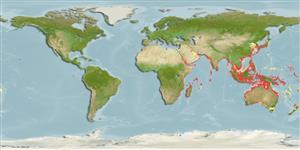Environment: milieu / climate zone / depth range / distribution range
Ökologie
seewasser demersal; tiefenbereich 10 - 55 m (Ref. 90102). Tropical
Indo-West Pacific: Red Sea and East Africa to Indonesia, north to southern Japan.
Size / Gewicht / Alter
Maturity: Lm ? range ? - ? cm
Max length : 15.0 cm TL Männchen/unbestimmt; (Ref. 4690); max. veröff. Gewicht: 33.00 g (Ref. 121532)
Rückenflossenstacheln (insgesamt) : 9 - 11; Rückenflossenweichstrahlen (insgesamt) : 10 - 12; Afterflossenstacheln: 2; Afterflossenweichstrahlen: 7 - 10.
Found near shore, including semi-enclosed sea areas; inhabits soft bottoms of the continental shelf (Ref. 11230). Anterolateral glandular grooves with venom gland (Ref. 57406). Sold in small quantities either fresh or dried and salted. Also found in sand bottoms in 10-55 m (Ref 90102).
Life cycle and mating behavior
Geschlechtsreife | Fortpflanzung | Ablaichen | Eier | Fecundity | Larven
Poss, S.G. and K.V. Rama Rao, 1984. Scorpaenidae. In W. Fischer and G. Bianchi (eds.) FAO species identification sheets for fishery purposes. Western Indian Ocean (Fishing Area 51). Vol. 4. FAO, Rome. pag. var. (Ref. 3503)
IUCN Rote Liste Status (Ref. 130435: Version 2024-2)
Nutzung durch Menschen
Fischereien: weniger kommerziell
Tools
Zusatzinformationen
Download XML
Internet Quellen
Estimates based on models
Preferred temperature (Ref.
123201): 22.3 - 29.1, mean 28.1 °C (based on 1274 cells).
Phylogenetic diversity index (Ref.
82804): PD
50 = 0.5002 [Uniqueness, from 0.5 = low to 2.0 = high].
Bayesian length-weight: a=0.02291 (0.00912 - 0.05752), b=2.94 (2.72 - 3.16), in cm total length, based on LWR estimates for this (Sub)family-body shape (Ref.
93245).
Trophic level (Ref.
69278): 3.9 ±0.7 se; based on size and trophs of closest relatives
Widerstandsfähigkeit (Ref.
120179): mittel, Verdopplung der Population dauert 1,4 - 4,4 Jahre. (Preliminary K or Fecundity.).
Fishing Vulnerability (Ref.
59153): Low vulnerability (10 of 100).
